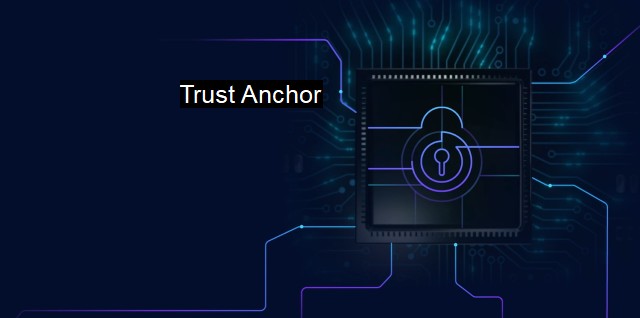What is Trust Anchor?
The Crucial Role of Trust Anchors in Cybersecurity: Ensuring the Security and Protection of Digital Certificates and Computer Devices
Trust anchor, a significant term widely used in cybersecurity and antivirus measures, refers to an entity that is explicitly trusted within a security system to certify a digital certificate's legitimacy. These digital certificates are pegged to their trust anchors, ensuring the comprehension and maintenance of the framework of trust within computer networks. the cybersecurity network would use a trusted point called the trust anchor to ascertain the legitimacy and ensure no viruses, malicious software, or cyber threats penetrate the system.Fundamentally, trust anchors have a cardinal role as the supreme hierarchical entities that form the basis of decision making for trust-related concerns. They facilitate the assessment of the trustworthiness of all components pertinent to cybersecurity, ranging from software to hardware to information systems. Interestingly, their raison d'être is commanding trust, fostering system-wide trust integration and, subsequently, improving the cyber defense against potential threats.
The mechanism of trust anchors is built on two fundamental bases: authenticity and credibility. In cybersecurity parlance, authentication implies the verification of digital certificates or cryptographic identities of software and hardware components, ensuring they are genuine and safeguarded from any illegitimate encroachment. On the other hand, credibility is all about the trust anchor's overall reputation and verifying whether it can be confidently used.
It is important to understand that trust anchors are typically represented by Cryptographic Key Pairs: a Private Key and a Public Key. The Private Key remains undisclosed, serving as the trust anchor owner's core secret tool to encode signatures. Simultaneously, the Public Key circulates publicly and authenticates the encoded signatures by matching them to its associated Private Key, thereby affirming electronic exchanges' adequacy and legitimacy.
Trust anchors operate in a hierarchical structure, forming what is known as a Chain of Trust. The model is such that every entity in the chain must trust all entities above it, leading to the topmost point: a trust anchor. This structure creates an alignment of trust, extending it from the roots (trust anchors) to the tree's furthest leaves (end entities). Hence a seamless interaction occurs within the network - where every component confirms its authenticity via a digital certificate descending from a root trust anchor.
The trust anchor's pinnacle role is its function in a Public Key Infrastructure (PKI), serving as the fundamental linchpin for cybersecurity operations. PKI is a configuration used to manage, distribute, store, and revoke digital certificates, establishing a spectrum of trust coordinations required to validate online transactions' authenticity. Consequently, any PKI has a list of trusted Root Certificates issued by Certificate Authorities (CAs) - these are inherently trust anchors.
While trust anchors are intrinsically safe, they are not immune to threats. Hackers can maliciously create rogue certificates to deceive the system and gain unfair access by exploiting the trust anchors. Therefore, entities controlling trust anchors exercise immense care in ensuring their security, performing regular audits of certificate logs and incessantly updating antivirus software to mind the shield against cyber threats.
To sum up, in cybersecurity and antivirus realms, Trust Anchors are a bedrock institution, forming the hierarchical basis for trust validation and chain authentication in computer systems. Acting as constant pillars of authentication and credibility, they shield the system from threats by relentlessly scrutinizing digital certificates and ensuring their propriety. Thus, Trust Anchors are absolutely crucial for any security-conscious organization keen on protecting its private systems against intrusive cyber threats. In this wavering digital world, Trust Anchors stand as immutable sentinels to keep security threats at bay.

Trust Anchor FAQs
What is a trust anchor in cybersecurity?
A trust anchor is a cryptographic term used in cybersecurity that refers to a trusted source in a security system that is used to verify and authenticate digital certificates. It is a critical component that ensures the authenticity and integrity of data transmitted within a network.How does a trust anchor work?
A trust anchor works by verifying the digital certificate of a website or application. When a user visits a website or downloads an application, the trust anchor checks the digital certificate to ensure that it has not been modified or forged. If it is verified as authentic, the trust anchor allows the user to access the website or application.Why is a trust anchor important for antivirus software?
A trust anchor is important for antivirus software because it helps to ensure that the antivirus is authentic and has not been compromised. When a user installs antivirus software, the trust anchor checks the digital certificate to verify that it is authentic and safe to use. This ensures that the antivirus software does not contain malware or other malicious code.What are the risks of not using a trust anchor in cybersecurity?
Not using a trust anchor in cybersecurity can result in security breaches and data theft. Without a trust anchor, it is difficult to verify the authenticity of digital certificates, which can make it easy for cybercriminals to impersonate legitimate websites and applications. This can lead to malware infections and other types of cyberattacks that can compromise the security of a network.| | A | | | B | | | C | | | D | | | E | | | F | | | G | | | H | | | I | | | J | | | K | | | L | | | M | |
| | N | | | O | | | P | | | Q | | | R | | | S | | | T | | | U | | | V | | | W | | | X | | | Y | | | Z | |
| | 1 | | | 2 | | | 3 | | | 4 | | | 7 | | | 8 | | |||||||